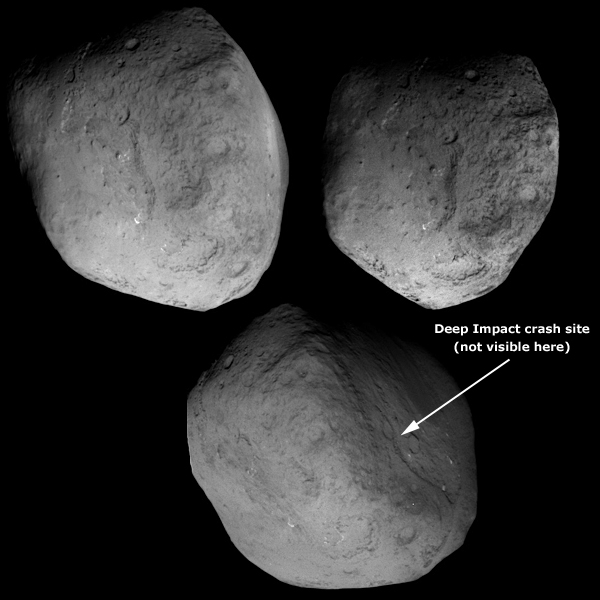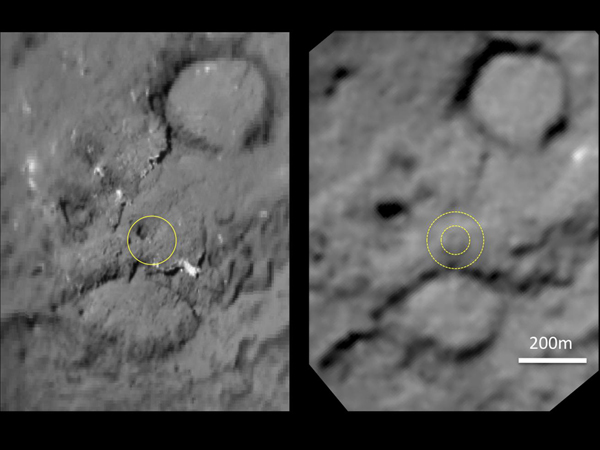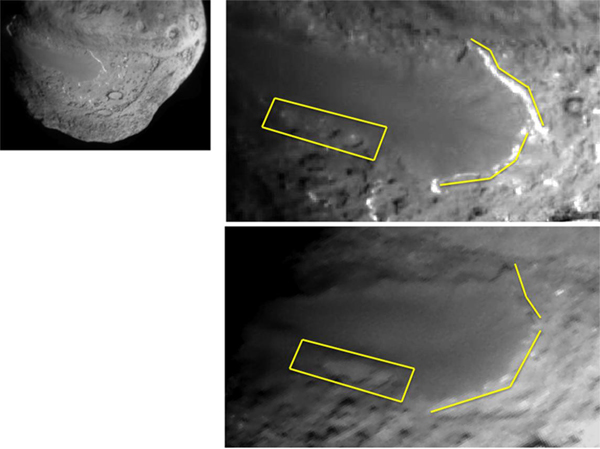Stardust-NExT zooms past comet Tempel 1 (UPDATED)
02/15/2011 09:17 PM Filed in: Space News | Space Science
Editor's note...
CBS News
Twelve years after launch and seven years after it collected dust from comet Wild 2, NASA's Stardust probe streaked past comet Tempel 1 late Monday, capturing 72 Valentine's Day closeups to find out how the icy body has changed since it was visited by another NASA spacecraft in 2005.
The renamed Stardust-New Exploration of Tempel mission -- Stardust-NExT -- passed within about 110 miles of the nucleus of Tempel 1 at 11:40 p.m. EST Monday, using its navigation camera to snap a string of images and recording thousands of dust grain impacts as it raced past at a relative velocity of 24,300 mph.
Because of an unexplained software glitch, it took longer than expected for the close-approach pictures to reach Earth, but that was of little consequence to the engineers, flight controllers and scientists eagerly awaiting the results.
"If you ask me was this mission 100 percent successful in terms of the science, I'd have to say no. It was a thousand percent successful!" Joe Veverka, the Stardust-NExT principal investigator at Cornell University, said Tuesday during a post-encounter news briefing.
The $300 million Stardust mission was launched in 1999. On Jan. 2, 2004, the spacecraft flew past comet Wild 2, using an innovative collector to capture particles from the coma, the cloud of debris surrounding the nucleus. Passing back by Earth two years later, a small re-entry capsule carrying the collected material was ejected and fell to a landing in Utah where it was recovered for detailed analysis.
In the meantime, NASA carried out the Deep Impact mission, sending another spacecraft to comet Tempel 1, a roughly potato-shaped body with a nucleus measuring 4.7 by 3 miles. During a dramatic encounter in 2005, Deep Impact released an instrumented probe that crashed into the comet, throwing up a cloud of debris from the surface. The Deep Impact spacecraft monitored the crash from a safe distance and carried out remote observations with cameras and other instruments.
With the Stardust probe still healthy after its successful mission to Wild 2, NASA approved a $29 million mission extension and agreed to send the spacecraft to Tempel 1 to study how the comet had changed during a full trip around the sun.
Veverka said Tempel 1 turned out to be "unusually interesting."
"In places on Tempel 1, we see layered terrains, which probably contain information about how comet nuclei are put together, and we would like to see more of these terrains," he said during a pre-encounter briefing, explaining why Tempel 1 was targeted for a second visit. "Deep Impact saw only about a third of the surface. We would like to see more."
Deep Impact also showed areas that appear to be smooth flow-like deposits, along with crater-like features that could be ancient vents.
But Veverka said the most important reason to return to Tempel 1 was that "this will be an opportunity, for the first time, to see how much a comet changes between two close passages to the sun."
"Deep Impact saw the comet in 2005, we're going to be seeing it one comet year later, just after its closest passage to the sun in 2011," he said. "We know comets lose material, but the question is, how much does the surface change and where does the surface change? So we'll be able to answer that question by comparing our images with those taken by Deep Impact in 2005."
After a quick assessment of the images returned by Stardust-NExT, Veverka said numerous surface features have, in fact, changed. The large flow-like deposit, for example, appears to be receding as water ice evaporates and carries dust particles away. In one area along the deposit's boundary, structures that were visible in 2005 appear to have eroded away.
The Valentine Day flyby was set up with a major rocket firing one year ago that put the craft on a trajectory that ensured it would be able to photograph the Deep Impact crash site as well as other, unseen areas of Tempel 1.
"That impact threw up so much ejecta that Deep Impact never saw the crater," Veverka said before the Stardust-NExT encounter. "So it could never complete the experiment, to see how big the crater is and what that tells us about the mechanical properties of the comet's surface. That's important if we're ever going to go back to a comet, land a spacecraft on the surface, dig up material from the surface, bring it back to Earth. ... So here, we have a chance to complete the deep impact experiment."
As it turned out, the targeting maneuver a year ago was right on the money and the Deep Impact crash site was captured by the Stardust-NExT navigation camera, although it was difficult for the untrained eye to make it out.
"We saw the crater," said Pete Schultz, a Stardust-NExT co-investigator at Brown University. "It's subdued, it's about 150 meters across and has a small central mound in the center. It looks as if from the impact, the stuff went up and came back down. So we did get it, there's no doubt. I think one of the bottom-line messages is that this surface of the comet where we hit is very weak. It's fragile. So the crater partly healed itself."
Stardust-NExT has covered some 3.5 billion miles since launch in 1999. The spacecraft is still healthy, but it does not have enough fuel left to carry out any additional encounters.
- Posted at 01:20 PM, 02/14/11: Stardust-NExT closes in on comet Tempel 1
- Updated at 12:10 AM, 02/15/11: Spacecraft flies past comet
- Updated at 03:05 AM, 02/15/11: Photo downlink delayed 45 minutes
- Updated at 04:55 AM, 02/15/11: Glitch delays reception of closeup images
- Updated at 12:15 PM, 02/15/11: Adding initial close-approach photos
- Updated at 05:00 PM, 02/15/11: Adding news conference; pictures
- Updated at 09:15 PM, 02/15/11: Adding pictures
CBS News
Twelve years after launch and seven years after it collected dust from comet Wild 2, NASA's Stardust probe streaked past comet Tempel 1 late Monday, capturing 72 Valentine's Day closeups to find out how the icy body has changed since it was visited by another NASA spacecraft in 2005.
The renamed Stardust-New Exploration of Tempel mission -- Stardust-NExT -- passed within about 110 miles of the nucleus of Tempel 1 at 11:40 p.m. EST Monday, using its navigation camera to snap a string of images and recording thousands of dust grain impacts as it raced past at a relative velocity of 24,300 mph.
 |
| Three views of comet Tempel 1 as seen by the Stardust-NExT spacecraft during close approach late Monday. The bottom image shows the general location of a crater that was excavated by NASA's Deep Impact probe during a 2005 encounter. (Credit: NASA) |
Because of an unexplained software glitch, it took longer than expected for the close-approach pictures to reach Earth, but that was of little consequence to the engineers, flight controllers and scientists eagerly awaiting the results.
"If you ask me was this mission 100 percent successful in terms of the science, I'd have to say no. It was a thousand percent successful!" Joe Veverka, the Stardust-NExT principal investigator at Cornell University, said Tuesday during a post-encounter news briefing.
 |
| A view of comet Tempel 1 as an instrumented probe crashed into its surface in 2005. (Credit: NASA) |
In the meantime, NASA carried out the Deep Impact mission, sending another spacecraft to comet Tempel 1, a roughly potato-shaped body with a nucleus measuring 4.7 by 3 miles. During a dramatic encounter in 2005, Deep Impact released an instrumented probe that crashed into the comet, throwing up a cloud of debris from the surface. The Deep Impact spacecraft monitored the crash from a safe distance and carried out remote observations with cameras and other instruments.
With the Stardust probe still healthy after its successful mission to Wild 2, NASA approved a $29 million mission extension and agreed to send the spacecraft to Tempel 1 to study how the comet had changed during a full trip around the sun.
Veverka said Tempel 1 turned out to be "unusually interesting."
"In places on Tempel 1, we see layered terrains, which probably contain information about how comet nuclei are put together, and we would like to see more of these terrains," he said during a pre-encounter briefing, explaining why Tempel 1 was targeted for a second visit. "Deep Impact saw only about a third of the surface. We would like to see more."
Deep Impact also showed areas that appear to be smooth flow-like deposits, along with crater-like features that could be ancient vents.
But Veverka said the most important reason to return to Tempel 1 was that "this will be an opportunity, for the first time, to see how much a comet changes between two close passages to the sun."
"Deep Impact saw the comet in 2005, we're going to be seeing it one comet year later, just after its closest passage to the sun in 2011," he said. "We know comets lose material, but the question is, how much does the surface change and where does the surface change? So we'll be able to answer that question by comparing our images with those taken by Deep Impact in 2005."
 |
| The view on the left was taken by the Deep Impact spacecraft before an instrumented probe crashed to the surface of comet Tempel 1. The photo on the right shows the view from the Stardust-NExT spacecraft as it flew past the comet Monday night. Scientists say the Deep Impact crash site is visible as a slight change in shading. (Credit: NASA) |
After a quick assessment of the images returned by Stardust-NExT, Veverka said numerous surface features have, in fact, changed. The large flow-like deposit, for example, appears to be receding as water ice evaporates and carries dust particles away. In one area along the deposit's boundary, structures that were visible in 2005 appear to have eroded away.
The Valentine Day flyby was set up with a major rocket firing one year ago that put the craft on a trajectory that ensured it would be able to photograph the Deep Impact crash site as well as other, unseen areas of Tempel 1.
 |
| Before-and-after images (top to bottom) showing erosion in a flow-like deposit on comet Tempel 1. (Credit: NASA) |
"That impact threw up so much ejecta that Deep Impact never saw the crater," Veverka said before the Stardust-NExT encounter. "So it could never complete the experiment, to see how big the crater is and what that tells us about the mechanical properties of the comet's surface. That's important if we're ever going to go back to a comet, land a spacecraft on the surface, dig up material from the surface, bring it back to Earth. ... So here, we have a chance to complete the deep impact experiment."
As it turned out, the targeting maneuver a year ago was right on the money and the Deep Impact crash site was captured by the Stardust-NExT navigation camera, although it was difficult for the untrained eye to make it out.
"We saw the crater," said Pete Schultz, a Stardust-NExT co-investigator at Brown University. "It's subdued, it's about 150 meters across and has a small central mound in the center. It looks as if from the impact, the stuff went up and came back down. So we did get it, there's no doubt. I think one of the bottom-line messages is that this surface of the comet where we hit is very weak. It's fragile. So the crater partly healed itself."
Stardust-NExT has covered some 3.5 billion miles since launch in 1999. The spacecraft is still healthy, but it does not have enough fuel left to carry out any additional encounters.